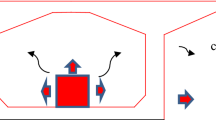Abstract
After the box girder was poured, the cement hydration generated heat and produced a large temperature difference in the girder, which may lead to the cracking. In order to study the hydration heat distribution and cracking risk of three-cell girder after pouring, the scale model of box girder was poured, 258 temperature sensors, solar radiation sensors and wind speed sensor were embedded in the model. Data receiving frequency was once every 30 min, and wireless acquisition module for data collection was used. After 96 h’ observation of temperature, the temperature field distribution of hydration heat of three-cell concrete girder was obtained. The finite element model of temperature field considering solar radiation and atmospheric convection was established. The maximum temperature change due to solar radiation was 29.8% of temperature change of hydration heat. The space and time model of vertical temperature difference during heat of hydration of concrete three-cell box girder was proposed for the first time. Based on response surface model and finite element model, the maximum vertical temperature difference of different web was proposed and was verified at the Wangjiahe Bridge. The predicted values of the Wangjiahe Bridge were in approximately agreement with the measured values. Compared to the initial concrete temperature of 35 °C without geotextile cover, the initial concrete temperature of 15 °C with 8 mm geotextile reduced the vertical temperature difference to 24.7% at most.























Similar content being viewed by others
References
Wu S, Huang D, Lin F, Zhao H, Wang P. Estimation of cracking risk of concrete at early age based on thermal stress analysis. J Therm Anal Calorim. 2011;105:171–86. https://doi.org/10.1007/s10973-011-1512-y.
Gajda J, Vangeem M. Controlling temperatures in mass concrete. Concr Inter. 2002;24(1):58–62. https://doi.org/10.14359/8464.
Bažant ZP, Jirásek M. Creep and hygrothermal effects in concrete structures: Springer. Dordrecht: The Netherlands; 2018.
Fairbairn EM, Azenha M. Thermal cracking of massive concrete structures. State of Art Report of the RILEM TC, 2018.
Potgieter IC. Response of highway bridges to nonlinear temperature distributions. , America: University of Illinois at Urbana-Champaign; 1983.
Lin Y, Chen H. Thermal analysis and adiabatic calorimetry for early-age concrete members. J Therm Anal Calorim. 2015;122:937–45. https://doi.org/10.1007/s10973-015-4843-2.
Nilsson M. Restraint factors and partial coefficients for crack risk analyses of early age concrete structures. Northboten, Sweden: Luleå tekniska university; 2003.
Abid SR, Atiya H, Tayşi N, Özakça M. Early age temperature distributions in reinforced concrete box-girder. In: 11th international congress on advances in civil engineering, 2014, p 1–7.
Yang W, Wu T, Fang Z. Actual measurement and analysis of heat of hydration of multi-cell concrete box girder. Highw Eng. 2017;42:254–60 (in Chinese).
Ye J, Jia L, Qian P. Observation and study on temperature distribution of concrete box girder. J Highw Transp Res Dev. 2002;32:788–793 (in Chinese)
Gong Y, Wang L, Bi H, Han F, Sun X. Hydration heat stress change rule in the construction of segment No. 0 of PC Box Girder Bridge. ICTE 2013: Safety, Speediness, Intelligence, Low-Carbon, Innovation; 2013:1969–75
Zang H, Liu Z, Wen W, Zhou X. Simulation of hydration heat effects on the box girder segments of the auxiliary bridge for Sutong bridge. J Highw Transp Res Dev. 2007;5:95–8.
Houssein NA, Gui LR, Bin G, Qing CZ. Study on the hydration heat temperature field of large-scale prestressed concrete box girder. IOSR J Eng. 2018;1:21–6.
BSI. BS EN 1991-1-5: 2003. Eurocode 1. Actions on structures. General actions. Thermal actions. In: BSI London; 2003.
Krkoška L, Moravčík M. The measurement of thermal changes on concrete box girder bridge. MATEC Web of Conferences: EDP Sciences; 2016:1003.
Abid SR, Tayşi N, Özakça M. Experimental Measurements on temperature gradients in concrete box-girder bridge under environmental loadings. Istanbul Bridge Conference; 2014.
Choi S, Cha SW, Oh BH, Kim IH. Thermo-hygro-mechanical behavior of early-age concrete deck in composite bridge under environmental loadings. Part 1: temperature and relative humidity. Mater Struct. 2011;44:1325–46. https://doi.org/10.1617/s11527-011-9751-8.
Choi S, Cha SW, Oh BH. Thermo-hygro-mechanical behavior of early-age concrete deck in composite bridge under environmental loadings. Part 2: strain and stress. Mater Struct. 2011;44:1347–67. https://doi.org/10.1617/s11527-011-9752-7.
Liu J, Liu Y, Zhang N, Ma Z, Bai Y. Research on temperature action and cracking risk of steel–concrete composite girder during the hydration process. Arch Civ Mech Eng. 2020;20:1–21. https://doi.org/10.1007/s43452-020-00050-0.
Zhang N, Zhou X, Liu Y, Liu J. In-situ test of hydration heat temperature field of concrete box beam based on point measurement. J Civ Eng. 2019;52:76–86 ((in Chinese)).
Wang T. Control of cracking in engineering structure. Beijing, China: China architecture and building press; 1997.
Zhu B. Thermal stresses and temperature control of mass concrete: Butterworth-Heinemann. Oxford: United Kingdom; 2013.
Lee Y, Kim J. Numerical analysis of the early age behavior of concrete structures with a hydration based microplane model. Comput Struct. 2009;87:1085–101. https://doi.org/10.1016/j.compstruc.2009.05.008.
Hill WJ, Hunter WG. A review of response surface methodology: a literature survey. Technometrics. 1966;8:571–90. https://doi.org/10.1080/00401706.1966.10490404.
Seberry J. Orthogonal designs: hadamard matrices, quadratic forms and algebras: Springer International Publishing. Berlin, Germany, 2017.
Montgomery DC. Design and analysis of experiments: John wiley & sons, New York, America. 2017
Acknowledgements
The co-authorial group would like to thank the National Natural Science Foundation of China (No. 51108249) and Shandong Provincial Natural Science Foundation Project (No. ZR202102260046 and No. ZR202102240664) for their valuable technical contributions adding to the significance of the results.
Author information
Authors and Affiliations
Corresponding author
Additional information
Publisher's Note
Springer Nature remains neutral with regard to jurisdictional claims in published maps and institutional affiliations.
Rights and permissions
Springer Nature or its licensor (e.g. a society or other partner) holds exclusive rights to this article under a publishing agreement with the author(s) or other rightsholder(s); author self-archiving of the accepted manuscript version of this article is solely governed by the terms of such publishing agreement and applicable law.
About this article
Cite this article
Zhang, F., Liu, J. Study on temperature distribution of three-cell box girder during the hydration process. J Therm Anal Calorim 148, 2629–2643 (2023). https://doi.org/10.1007/s10973-022-11919-y
Received:
Accepted:
Published:
Issue Date:
DOI: https://doi.org/10.1007/s10973-022-11919-y



